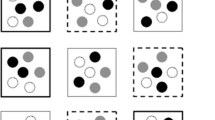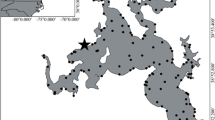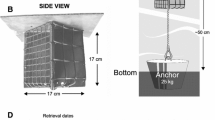Abstract
Field manipulation experiments were performed in the Exe Estuary, south west England, in October 1988, to investigate the importance of the meiofaunamacroinfauna trophic link in benthic trophodynamics. Four hypothetically meiofauna-predacious endobenthic macrofauna species were selected for manipulation using the criteria of high abundance and different modes of feeding: Cerastoderma edule (filter-feeder), Nereis diversicolor (omnivorous scavenger), Ophelia bicornis (sand-ingester), Scrobicularia plana (deposit-feeder). Enclosures constructed from plastic tubing, 63 μm nylon monofilament mesh and galvanized steel were deployed, containing adult members of these taxa at densities raised to approximately four times that of the surrounding sediment. The experiments ran for 12 tidal cycles. Differences in phyletic meiofaunal abundance between treatment and control enclosures at the termination of the experiment were assessed using both uni- and multivariate dataanalysis techniques. Only two univariate significant differences (p<0.05) existed for the N. diversicolor treatment and two for the S. plana treatment. Annelida, Turbellaria and copepod nauplii were the only meiofauna taxa affected. No univariate significant differences were recorded for either the C. edule or O. bicornis treatments. Multidimensional scaling ordination of the data revealed no consistent changes in community composition between treatments and controls. It is concluded that the experiments provide evidence of minimal predation by macroinfauna upon meiofauna.
Similar content being viewed by others
Literature cited
Austen, M. C. (1986). Factors affecting meiobenthic community structure in the Tamar estuary. PhD dissertation. Exeter University, England
Bell, S. S., Hicks, G. R. F., Walters, K. (1989). Experimental investigations of benthic reentry by migrating meiobenthic copepods. J. exp. mar. Biol. Ecol. 130: 291–303
Bell, S. S., Sherman, K. M. (1980). A field investigation of meiofaunal dispersal: tidal resuspension and implications. Mar. Ecol. Prog. Ser. 3: 245–249
Boalch, G. T. (1980). Essays on the Exe Estuary. Devonshire Association for the Advancement of Science, Literature and Art, Exeter, England (Spec. Vol. No. 2)
Bonsdorff, E., Mattila, J., Ronn, C., Osterman, C. (1986). Multidimensional interactions in shallow soft-bottom ecosystems; testing the competitive exclusion principle. Ophelia (Suppl. 4): 37–44
Commito, J. A., Shrader, P. B. (1985). Benthic community response to experimental additions of the polychaete Nereis virens. Mar. Biol. 86: 101–107
Connell, J. H. (1974). Ecology: field experiments in marine ecology. In: Mariscal, R. (ed.) Experimental marine biology. Academic Press, New York, p. 21–54
Coull, B. C. (1973). Estuarine meiofauna: a review: trophic relationships and microbial interactions. In: Stevenson, L. H., Colwell, R. R. (eds.) Estuarine microbial ecology. University of South Carolina Press, Columbia, p. 499–512
Ellis, M. J., Coull, B. C. (1989). Fish predation on meiobenthos: field experiments with juvenile spot Leiostomus xanthurus Lacepède. J. exp. mar. Biol., Ecol. 130: 19–32
Eltringham, S. K. (1971). Life in mud and sand. The English Universitie Press Ltd., London
Fenchel, T. (1978). The ecology of micro-and meiobenthos. A. Rev. Ecol. Syst. 9: 99–121
Fitzhugh, G. R., Fleeger, J. W. (1985). Goby (Pisces: Gobiidae) interactions with meiofauna and small macrofauna. Bull. mar. Sci. 36: 436–444
Frid, C. L. J., James, R. (1988). The role of epibenthic predators in structuring the marine invertebrate community of a British coastal salt marsh. Neth. J. Sea Res. 22: 307–314
Gee, J. M. (1987). Impact of epibenthic predation on estuarine intertidal harpacticoid copepod populations. Mar. Biol. 96: 497–510
Gerlach, S. A. (1971). On the importance of marine meiofauna for benthos communities. Oecologia 6: 179–190
Gerlach, S. A. (1978). Food chain relationships in subtidal silty sand marine sediments and the role of meiofauna in stimulating bacterial productivity. Oecologia 33: 55–69
Harris, T. (1988). Ecological aspects of the biology of Ophelia bicornis Savigny. PhD dissertation. Exeter University, England
Hicks, G. R. F. (1986). Distribution and behavior of meiofaunal copepods inside and outside seagrass beds. Mar. Ecol. Prog. Ser. 31: 159–170
Hobson, E. S., Chess, J. R. (1979). Zooplankters that emerge from the lagoon floor at night at Kure and Midway Atolls, Hawaii. Fish. Bull. U. S. 77: 275–280
Hughes, R. N. (1969). A study of feeding in Scrobicularia plana. J. mar. biol. Ass. U.K. 49: 805–823
Hughes, R. N. (1970). Population dynamics of the bivalve Scrobicularia plana (Da Costa) on an intertidal mud-flat in North Wales. J. Anim. Ecol. 39: 333–357
Jonge, V. N. de, Bouwman, L. A. (1977). A simple density separation technique for quantitative isolation of meiobenthos using the colloidal silica Ludox-TM. Mar. Biol. 42: 143–148
Kuipers, B. R., Wilde, P. A. W. J. de, Creutzberg, F. (1981). Energy flow in a dital flat ecosystem. Mar. Ecol. Prog. Ser. 5: 215–221
McIntyre, A. D. (1971). Control factors on meiofaunal populations. Thalassia jugost. 7: 209–215
McIntyre, A. D., Warwick, R. M. (1984). Meiofaunal techniques. In: Holme, N. A., McIntyre, A. D. (eds.) Methods for the study of the marine benthos; 2nd edn. Blackwell Scientific Publications, Oxford, p. 217–244 (IBP Handbk No. 16)
Nicol, J. A. C. (1967). The biology of marine animals. John Wiley & Sons, New York
Olafsson, E. B., Persson, L. P. (1986). The interaction between Nereis diversicolor O. F. Müller and Corophium volutator Pallas as a structuring force in a shallow brackish sediment. J. exp. mar. Biol. Ecol. 103: 103–117
Perkins, E. J. (1958). The food relations of the microbenthos with particular reference to that found at Whitstable, Kent. Ann. Mag. nat. Hist. 1: 64–77
Peterson, C. M. (1979). Predation, competitive exclusion, and diversity in the soft-sediment communities of estuaries and lagoons. In: Livingstone, R. J. (ed.) Ecological processes in coastal and marine systems. Plenum Press, New York, p. 233–264
Raffaelli, D., Conacher, H., McLachlan, H., Emes, C. (1989). The role of epibenthic crustacean predators in an estuarine food web. Estuar., cstl Shelf Sci. 28: 149–160
Reise, K. (1979). Moderate predation on meiofauna by the macrobenthos of the Wadden Sea. Helgoländer wiss. Meeresunters. 32: 453–465
Reise, K. (1985). Predator control in marine tidal sediments. Proc. 19th Eur. mar. Biol. Symp. 311–321 [Gibbs, P. E. (ed.) Cambridge University Press, Cambridge]
Robichaux, D. M., Cohen, A. C., Reaka, M. L., Allen, D. (1981). Experiments with zooplankton on coral reefs, or, will the real demersal plankton please come up? Pubbl. Staz. zool. Napoli (I: Mar. Ecol.) 2: 77–94
Ronn, C., Bonsdorff, E., Nelson, W. (1988). Predation as a mechanism of interference within infauna in shallow brackish water soft bottoms: experiments with an infaunal predator Nereis diversicolor O. F. Müller. J. exp. mar. Biol. Ecol. 116: 143–157
Sarvala, J. (1971). Ecology of Harmothoe sarsi (Malmgren) (Polychaeta: Polynoidae) in the northern Baltic area. Annls zool. fenn. 8: 231–309
Schubert, A., Reise, K. (1986). Predatory effects of Nepthys hombergii on other polychaetes in tidal flat sediments. Mar. Ecol. Prog. Ser. 34: 117–124
Shaffer, P. L. (1979). The feeding biology of Podarke pugettensis (Polychaeta: Hesionidae). Biol. Bull. mar. biol. Lab., Woods Hole 156: 343–355
Vahl, O. (1973). Porosity of the gill, oxygen consumption and pumping rate in Cardium edule (L.) (Bivalvia). Ophelia 10: 109–118
Virnstein, R. W. (1977). The importance of predation by crabs and fishes on benthic infauna in Chesapeake Bay. Ecology 58: 1199–1217
Virnstein, R. W. (1979). Predation on estuarine infauna: response patterns of component species. Estuaries 2: 69–86
Walters, K., Bell, S. S. (1985). Diel patterns of active vertical migration in seagrass meiofauna. Mar. Ecol. Prog. Ser. 34: 95–103
Wilson, W. H. J. (1986). Importance of predatory infauna in marine soft-sediment communities. Mar. Ecol. Prog. Ser. 32: 35–40
Zwarts, L. (1986). Burying depth of the benthic bivalve Scrobicularia plana (da Costa) in relation to siphon-cropping. J. exp. mar. Biol. Ecol. 101: 25–39
Zwarts, L., Wanink, J. (1989). Siphon size and burying depth in deposit- and suspension-feeding benthic bivalves. Mar. Biol. 100: 227–240
Author information
Authors and Affiliations
Additional information
Communicated by J. Mauchline, Oban
Rights and permissions
About this article
Cite this article
Kennedy, A.D. Minimal predation upon meiofauna by endobenthic macrofauna in the Exe Estuary, south west England. Marine Biology 117, 311–319 (1993). https://doi.org/10.1007/BF00345676
Received:
Accepted:
Issue Date:
DOI: https://doi.org/10.1007/BF00345676




